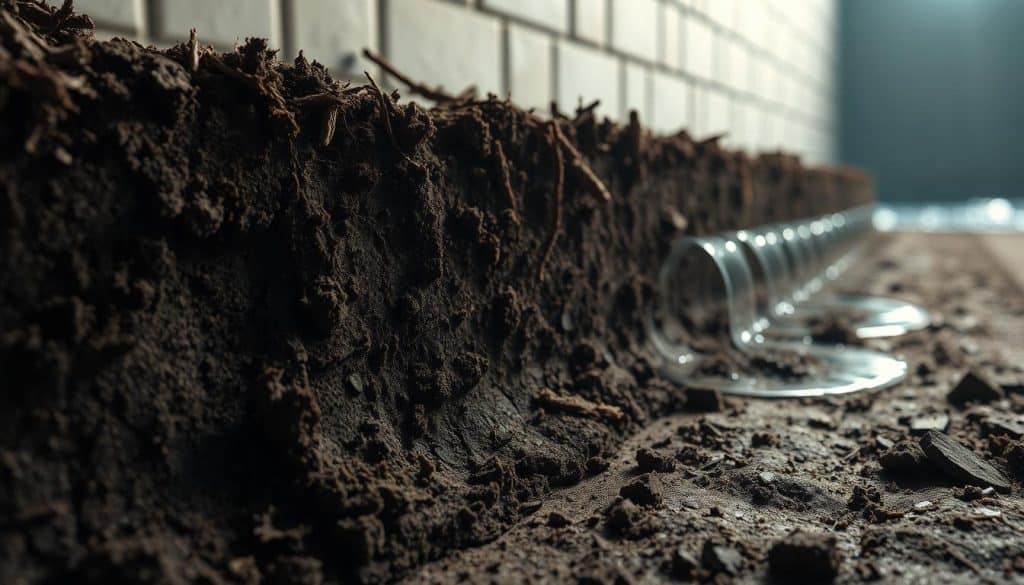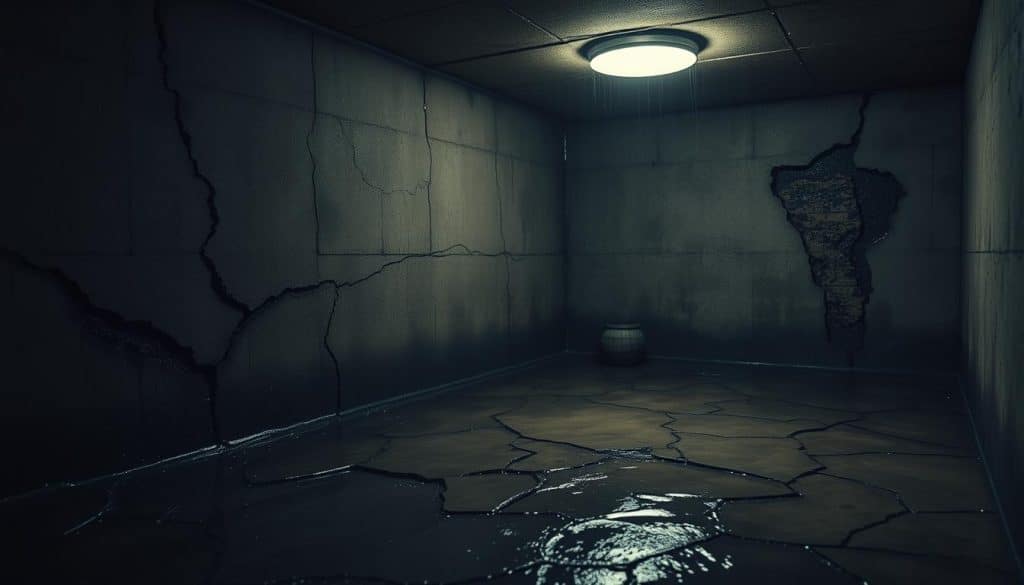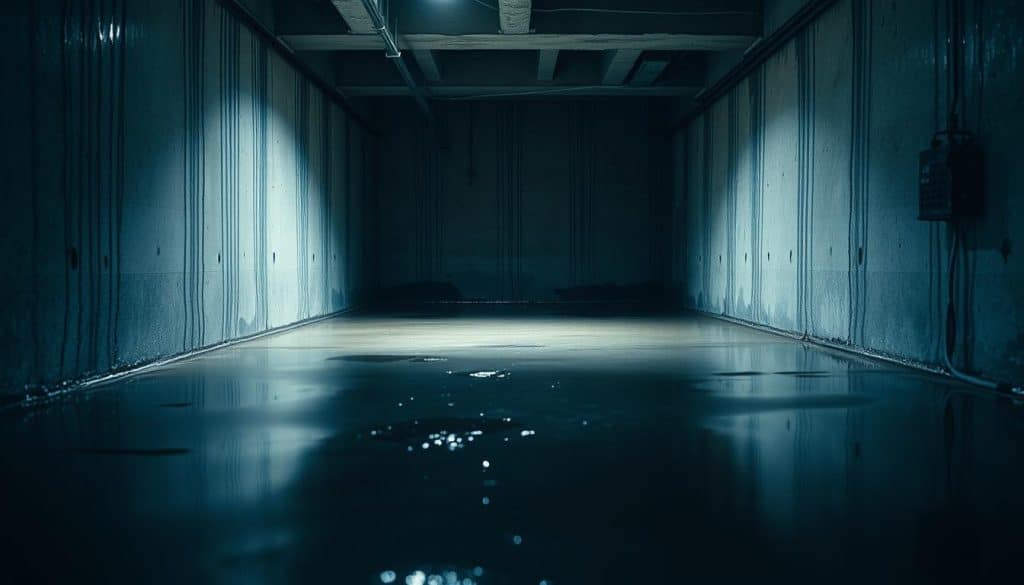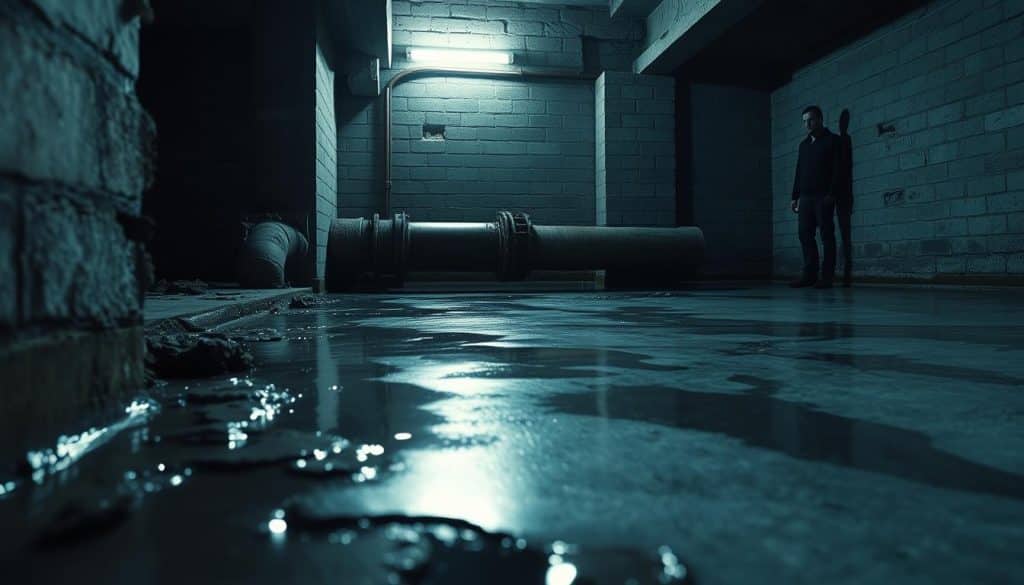Table of Contents
Ever wondered why water often ends up in basements? What Causes Water in The Basement? Knowing what causes basement flooding is key to protecting your home. Water in the basement can damage your house and harm your health. It can come from heavy rain, bad drainage, foundation cracks, or groundwater.
Spotting these problems early helps fix them and prevents future issues. This way, you can keep your home safe and dry for years to come.
Key Takeaways
- Water seepage is common, mainly in places like Pennsylvania, New Jersey, and Delaware.
- Foundation cracks can cause a lot of water damage if not fixed quickly.
- Keeping gutters and landscaping in check can stop flooding problems.
- Checking sump pumps regularly is important to avoid basement flooding from pump failures.
- Mold and mildew grow fast in damp basements, which is bad for your health.
Understanding the Common Causes of Basement Water Issues
Basement flooding can cause a lot of damage and be very expensive. Knowing why water gets into basements helps fix problems early. Many things can lead to water in basements, like heavy rain or weak structures.
Heavy Rainfall and Poor Drainage
When it rains a lot, drainage systems can fail. This lets water build up against foundation walls. The pressure from this water can push through materials like concrete, causing leaks.
It’s important to check gutters and downspouts often. This keeps water from pooling and reduces the chance of flooding. Places with lots of rain or flash floods are at higher risk.

Foundation Cracks and Leaks
Cracks or leaks in the foundation let water into the basement. These can happen over time due to soil movement or bad construction. It’s key to look for damage and fix any cracks to stop water from getting in.
Ignoring foundation problems can lead to more water damage and higher repair costs. Regular checks and quick fixes are important.
Groundwater Seepage
High groundwater levels during heavy rain or snowmelt can cause basement leaks. When the soil around the foundation gets too wet, it pushes against the walls. This makes water get in more easily.
Installing sump pumps or better drainage systems can help. Fixing groundwater issues is critical for a dry and safe basement.
The Role of Soil Composition in Water Accumulation
The soil around a property greatly affects how water interacts with the foundation. Knowing about soil types helps understand moisture and drainage issues. Different soils handle rainfall and groundwater in unique ways, affecting how they absorb and hold water.
Clay-soil vs. Sandy-soil Dynamics
Clay soil holds onto moisture more than sandy soil, leading to water buildup near foundations. This can cause high hydrostatic pressure, which increases by 30% during heavy rains. Sandy soils, on the other hand, drain water faster, reducing moisture problems.
Knowing the soil type is key for managing water around homes.
How Soil Compaction Affects Drainage
Soil compaction changes how well it drains. When soil is compacted, like from foot traffic or construction, it can’t absorb water as well. This causes water to pool around foundations.
Compaction can add 10% to hydrostatic pressure. Using good landscaping helps keep soil healthy and improves drainage, lowering moisture risks.
The Impact of House Structure on Basement Water
The design and structure of your home are key in managing water, mainly in the basement. Elements like gutters, downspouts, and the land’s slope affect water drainage. Fixing these can stop foundation problems and cut down basement leaks.
Effect of Gutters and Downspouts
Gutters and downspouts must work right to keep rainwater away from your foundation. If they’re clogged or water is dumped too close, it causes drainage issues. This can lead to water pooling and basement leaks.
Regular upkeep is vital. It ensures gutters and downspouts direct water away, avoiding foundation problems.
Slope of the Land Around Your Home
The land around your home should slope away from the foundation. This helps water flow correctly. If the yard slopes towards the foundation, getting it graded by a pro is a good idea.
Good grading reduces water around the foundation. It also lowers the risk of damage from water pressure, saving you money on repairs.
Identifying Signs of Water Issues in Basements
Spotting moisture problems early is key to a home’s health. Knowing the signs can help stop basement flooding before it’s too late. Regular checks can reveal important signs of water buildup, avoiding costly fixes.
Common Symptoms of Water Accumulation
Look out for damp smells and mold, which mean hidden moisture. Mold can cause breathing problems and allergies, so act fast. Efflorescence, or white deposits, on walls or floors is another warning sign, often seen in older basements.
Small cracks in walls can let in a lot of water. Fixing these cracks quickly stops foundation problems and flooding. Damp floors or walls show moisture, which can weaken your home. Water stains near windows and doors mean leaks in the walls.
Importance of Early Detection
Finding water problems early stops big damage and saves money. Check basements and crawl spaces for leaks and dampness often. Use a hygrometer to check humidity; above 50% is bad for mold.
A broken sump pump means water is building up, risking floods. Keeping your home well-maintained keeps it safe and healthy. Fixing problems early stops bigger issues later.
How to Prevent Water from Entering Your Basement
To keep water out of your basement, you need to act early. Regular upkeep and the right waterproofing can help a lot. Simple checks and advanced systems can keep water from getting in.
Regular Maintenance Tips
Checking your home’s drainage systems is key. Make sure gutters and downspouts are clear to avoid water buildup. Downspouts should go at least four feet away from your home to keep water off.
Look for cracks in your foundation and walls. Fix them quickly to stop leaks. Also, make sure your yard slopes away from your basement to help with drainage.
Use of French Drains
French drains help move water away from your home’s base. They use pipes in gravel to collect and move water. This reduces pressure on your basement walls.
A drain tile system and a sump pump can also help. They work together to keep your basement dry. For the best results, get help from experts like Array of Solutions.

When to Seek Professional Help for Water Problems
Spotting water seepage in your basement early is key to avoiding big foundation problems. Keep an eye out for constant moisture, water pooling, or structural damage. These signs often mean leaks are getting worse and could lead to mold.
Mold can harm your home’s structure and your health. It’s important to act fast when you see these signs.
Signs You Need Expert Evaluation
Moisture, musty smells, or water stains on walls mean you need a pro to check it out. Water problems can come from many sources. Ignoring them can cost a lot to fix, from $1,000 to $5,000.
Fixing these issues quickly can stop bigger problems. Mold can grow fast, within 24 to 48 hours after water damage.
How Array of Solutions Can Assist
Array of Solutions helps with water problems through their detailed services. They can find where water is coming from and fix it. With over 70 years of experience, they offer custom solutions for your basement.
They have great reviews and are known for excellent service. They’re ready to help 24/7, making them a trusted choice for homeowners.
Understanding the Cost Implications of Water Damage
Many homeowners don’t realize how much water damage can cost until it happens. The cost to fix water damage can range from $350 for small issues to over $20,000 for major problems. In the U.S., about 14,000 people deal with water damage emergencies every day. Ignoring early signs of moisture can lead to even higher costs later on.
Potential Repair Costs
Figuring out repair costs depends on how bad the water damage is. For example, removing water from a lightly flooded basement can cost $500 to $1,000. But, if the damage is more severe, it can cost up to $10,000 for flooring and walls. Insurance usually covers sudden accidents, but it often doesn’t cover neglect. This means homeowners might have to pay for repairs themselves.
Restoring damaged areas can cost around $3,000. This is close to the national average of $1,200 to $5,000 for common repairs.
Long-term Savings with Proactive Solutions
Choosing proactive solutions can save homeowners a lot of money in the long run. Regular maintenance and basement waterproofing can prevent big damage and save on repair costs. By taking steps to prevent problems, homeowners can avoid expensive fixes like mold remediation.
Mold can start growing in just 24 to 48 hours after water damage. This can increase repair costs and pose health risks. Knowing your insurance policy well and taking proactive steps can save a lot of money. For more on waterproofing benefits, check out this page.
The Importance of Mold Testing in Water-Prone Areas
It’s key to tackle mold problems fast to keep your indoor space healthy, mainly in areas that get a lot of water. Mold grows well in damp places and can harm your health. Testing for mold in these spots is a vital step to avoid health issues caused by mold.
Health Risks Associated with Mold
Mold spores are tiny and can cause health problems like breathing issues, allergies, and make asthma worse. People like babies, kids, the elderly, and those with weak immune systems are more at risk. Because mold grows fast, acting quickly is important. If items can’t be cleaned or dried in a short time, it’s best to throw them away to avoid health risks.
The Role of Array of Solutions in Mold Inspections
Array of Solutions is an expert in mold inspections. They offer detailed mold testing services to quickly solve moisture issues. They find hidden mold, which can be up to 30% of cases behind walls or under floors. With their help, you can protect your home from hidden dangers and keep the air inside cleaner.
Local Services Offered by Array of Solutions
Array of Solutions offers vital water damage services across South Carolina. They ensure homeowners get top-notch help when they need it most. Their wide reach helps them serve many communities, where water damage can be a big problem.
Areas Served in South Carolina
Array of Solutions is in key places like Greenville, Spartanburg, Greer, and Easley. They offer mold removal and restoration services that fit the needs of South Carolina homeowners. With over 15 years of experience, they’re known for their reliable water damage restoration services.
Quick Response and Personalized Attention
Array of Solutions is quick to respond to water and mold issues. They know mold can grow fast after water damage. Their certified team does fast assessments and acts quickly.
They also give personalized service to each homeowner. This means they get solutions that fit their specific needs. This approach helps in recovery and reduces risks from untreated water exposure.
Contacting Array of Solutions for Water and Mold Services
If you’re worried about water damage or mold, acting fast is key. Good water and mold services keep your home safe and healthy. To reach Array of Solutions, call (864) 710-6413 or email scmoldremoval@gmail.com. Their team is ready to help with your questions and needs.
How to Reach Us: Phone and Email
Array of Solutions is all about fixing water and mold issues. They make sure your home is safe and comfy. Feel free to ask questions or book an inspection. They respond quickly to offer advice that fits your situation.
Schedule Your Mold Inspection Today
Don’t let mold problems get worse. Book your mold inspection now. Array of Solutions offers quick and affordable services. They check and fix mold risks in just 24 hours. With them, your home stays safe from mold and moisture.

FAQ
What are the main causes of water in the basement?
How can I tell if my basement is at risk for flooding?
What preventative measures can I take to avoid water issues in my basement?
Why is soil type important for basement drainage?
When should I consider hiring a professional for my basement water problems?
How much can repairs for basement water damage cost?
FAQ
What are the main causes of water in the basement?
Water in the basement can come from heavy rain, bad drainage, and groundwater. Plumbing leaks and foundation cracks also play a role. These issues can harm your home’s structure.
How can I tell if my basement is at risk for flooding?
Look for damp walls, peeling paint, musty smells, and mold. Catching these signs early can prevent bigger problems.
What preventative measures can I take to avoid water issues in my basement?
Keep gutters and downspouts clean, seal foundation cracks, and ensure good drainage. French drains and sloped landscaping can also help.
Why is soil type important for basement drainage?
Soil type affects how it holds water. Clay soils keep moisture, while sandy soils drain faster. This impacts your basement’s water situation.
When should I consider hiring a professional for my basement water problems?
If you see constant moisture, standing water, or structural damage, get professional help. Experts like Array of Solutions can offer solutions.
How much can repairs for basement water damage cost?
Costs vary. Fixing small cracks might cost $160, while full waterproofing can be $1,200 to $5,000 or more. It depends on the damage.
What health risks are associated with mold in the basement?
Mold can cause serious health problems, like breathing issues and allergies. It’s important to find and fix mold quickly, for everyone’s health.
How quickly can Array of Solutions respond to my inquiries for water and mold services?
Array of Solutions aims for quick responses, usually within 24 hours. They work fast to address your concerns.

